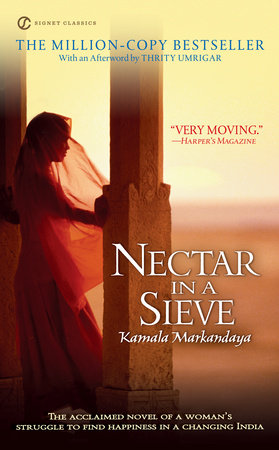READERS GUIDE
Questions and Topics for Discussion
NTRODUCTION
Set in India during a period of intense urban development, Nectar in a Sieve was first published in 1954, a few years after India gained political independence from Britain. It is the poignant story of a large poverty-stricken Hindu family in a remote rural village in southern India. The story is told in the first person by Rukmani, beginning with her arranged marriage at age twelve to tenant farmer Nathan.
Rukmani and Nathan love each other and their marriage begins in relative peace and prosperity; however, a large tannery is built in the neighboring village and begins insidiously destroying their lives. As the tannery grows larger and more prosperous, Rukmani and Nathan struggle to feed their children and to pay the rent on the land that gives them life. Although matters continue to worsen, they quietly persevere through ever-increasing hardships—flood, famine, even death—and cling to their hopes for a better future.
ABOUT KAMALA MARKANDAYAKamala Markandaya was born in 1924 in Mysore, in southern India. Between 1940 and 1947, she worked as a journalist and published short stories in Indian newspapers. She married an Englishman and immigrated to England in 1948, where she had one daughter.
Markandaya published Nectar in a Sieve, her first novel, in 1954, to wide critical acclaim. A huge commercial success, it quickly became a modern classic. Author Shashi Tharoor put it best when he said, “Markandaya was a pioneer who influenced all of us Indians writing in English.”
DISCUSSION QUESTIONSThe novel is told through first person narration, many years after the story takes place. Why might the author have used this technique? How would the novel have been different if it had been told through Rukmani’s perspective as a child, or if a different character narrated the story?The concept of hope is central to this novel. How do Rukmani and Nathan show their hope? What keeps them hopeful?Why does Rukmani choose not to tell Nathan that she has gone to Kenny for help with her infertility? How does she eventually find peace in telling him the truth?How does the coming of the tannery affect the family’s life? How do the various characters react to its presence? Why?One of the ironies of peasant life, as portrayed in the novel, is that sons are required to maintain the family’s subsistence. However, more children mean more mouths to feed. Why are sons so important? What keeps the sons in the novel from working the fields?Rukmani teaches all of her children to read and write, even though many in her village believe this can lead to trouble. What would have happened to her children if she had not done so? How else throughout the novel do the characters demonstrate knowledge as a powerful catalyst for change?Throughout the novel Kenny’s views of the peasants and Rukmani’s views of Kenny and other white men set up an interesting debate. Do you agree with either of them? Is there a common ground?At the time this novel was written, child marriage was a common practice in India. Why do you think this was so ingrained in the culture? How do you think its prohibition has changed life in India?The title Nectar in a Sieve comes from a poem by Samuel Taylor Coleridge called “Work Without Hope”: “Work without Hope draws nectar in a sieve, / And Hope without an object cannot live.” What does this mean? Why do you think Markandaya chose it for the title of her novel?How does Markandaya address the fundamental question of Hindu belief: what does it mean to be human?

